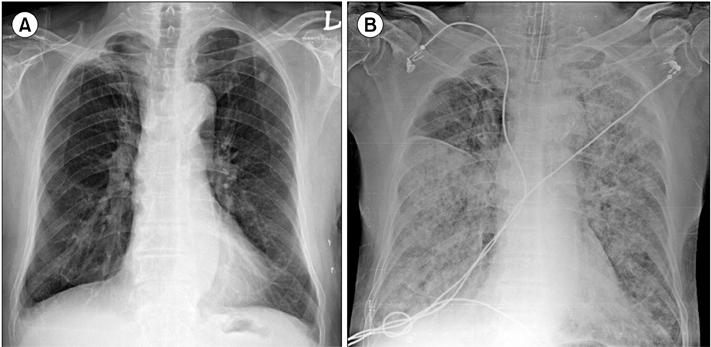Korean J Hematol.
2012 Dec;47(4):302-306. 10.5045/kjh.2012.47.4.302.
A case of transfusion-related acute lung injury induced by anti-human leukocyte antigen antibodies in acute leukemia
- Affiliations
-
- 1Department of Internal Medicine, CHA University School of Medicine, Seongnam, Korea. doh@cha.ac.kr
- 2Department of Laboratory Medicine, CHA University School of Medicine, Seongnam, Korea.
- 3Department of Laboratory Medicine, Seoul National University College of Medicine, Seoul, Korea.
- KMID: 1832111
- DOI: http://doi.org/10.5045/kjh.2012.47.4.302
Abstract
- Transfusion-related acute lung injury (TRALI) is a noncardiogenic pulmonary edema that occurs during or within 6 hours after transfusion. Risk factors for TRALI, which is relatively common in critically ill patients, include recent surgery, hematologic malignancy, and sepsis. Here, we report a case of TRALI induced by anti-human leukocyte antigen (anti-HLA) class II antibodies (HLA-DR) occurring after transfusion of platelet concentrates in a patient with acute leukemia. Although most patients with TRALI show improvement within 48-96 hours, our patient's condition rapidly worsened, and he did not respond to supportive treatment. TRALI is a relatively common and serious adverse transfusion reaction that requires prompt diagnosis and management.
Keyword
MeSH Terms
Figure
Cited by 1 articles
-
Serious Adverse Transfusion Reactions Reported in the National Recipient-Triggered Trace Back System in Korea (2006-2014)
Jeong Ran Kwon, Eun Jeong Won, Hyun Jung Jo, Sae Rom Choi, Kyoungyul Lee, Sinyoung Kim, Hyeong Sik Ahn, Young Sill Choi, Duck Cho, Dong Han Lee
Ann Lab Med. 2016;36(4):335-341. doi: 10.3343/alm.2016.36.4.335.
Reference
-
1. Toy P, Popovsky MA, Abraham E, et al. Transfusion-related acute lung injury: definition and review. Crit Care Med. 2005. 33:721–726.
Article2. Huh JY, Han TH, Seo JW, Kim DC, Roh DH, Han KS. A case of transfusion-related acute lung injury. Korean J Blood Transfus. 2005. 16:250–254.3. Lee KJ, Kim HO, Kim JH, et al. Two cases of transfusion related acute lung injury. Tuberc Respir Dis. 2006. 61:473–478.
Article4. Lee JH, Kang ES, Kim DW. Two cases of transfusion-related acute lung injury triggered by HLA and anti-HLA antibody reaction. J Korean Med Sci. 2010. 25:1398–1403.
Article5. Lee HJ, Jeong MA, Jeong JS, Han MK, Jun JH. A case of acute lung injury after transfusion during cesarean section: a case report. Korean J Crit Care Med. 2011. 26:184–187.
Article6. Hong YJ, Kim JA, Choi Q, et al. Diagnosis of transfusion-related acute lung injury (TRALI) in a heart failure patient. Korean J Blood Transfus. 2011. 22:271–276.7. Kim KW, Park JS, Kim JW, et al. A suspected case of Transfusion-related acute lung injury in a 30-year old parturient with gestational ITP: A case report. Anesth Pain Med. 2011. 6:275–279.8. Bae SH, Kim JE, Lee JM, Hah JO, Cho HS. Transfusion-related acute lung injury with hemophagocytic lymphohistiocytosis in aplastic anemia: case report. Clin Pediatr Hematol Oncol. 2011. 18:152–156.9. Kim YJ, Heo S. "Possible TRALI" developed during bilateral total knee arthroplasty replacement: a case report. Korean J Anesthesiol. 2012. 62:73–78.
Article10. Middelburg RA, van Stein D, Briet E, van der Bom JG. The role of donor antibodies in the pathogenesis of transfusion-related acute lung injury: a systematic review. Transfusion. 2008. 48:2167–2176.
Article11. Silliman CC, Ambruso DR, Boshkov LK. Transfusion-related acute lung injury. Blood. 2005. 105:2266–2273.
Article12. Sachs UJ, Wasel W, Bayat B, et al. Mechanism of transfusion-related acute lung injury induced by HLA class II antibodies. Blood. 2011. 117:669–677.
Article13. Popovsky MA, Moore SB. Diagnostic and pathogenetic considerations in transfusion-related acute lung injury. Transfusion. 1985. 25:573–577.
Article14. Silliman CC, Voelkel NF, Allard JD, et al. Plasma and lipids from stored packed red blood cells cause acute lung injury in an animal model. J Clin Invest. 1998. 101:1458–1467.
Article15. Looney MR, Gropper MA, Matthay MA. Transfusion-related acute lung injury: a review. Chest. 2004. 126:249–258.16. Gajic O, Rana R, Winters JL, et al. Transfusion-related acute lung injury in the critically ill: prospective nested case-control study. Am J Respir Crit Care Med. 2007. 176:886–891.
Article17. Vlaar AP, Binnekade JM, Prins D, et al. Risk factors and outcome of transfusion-related acute lung injury in the critically ill: a nested case-control study. Crit Care Med. 2010. 38:771–778.
Article18. Silliman CC, Boshkov LK, Mehdizadehkashi Z, et al. Transfusion-related acute lung injury: epidemiology and a prospective analysis of etiologic factors. Blood. 2003. 101:454–462.
Article19. Kim HO. Guidelines for appropriate and safe transfusion. J Korean Med Assoc. 2006. 49:391–401.
Article20. Cable R, Carlson B, Chambers L, editors. Practice guidelines for blood transfusion: A compilation from recent peer-reviewed literature. 2007. 2nd ed. Peoria, IL: American Red Cross;22–23.21. Eder AF, Herron R, Strupp A, et al. Transfusion-related acute lung injury surveillance (2003-2005) and the potential impact of the selective use of plasma from male donors in the American Red Cross. Transfusion. 2007. 47:599–607.
Article22. Silliman CC, Dickey WO, Paterson AJ, et al. Analysis of the priming activity of lipids generated during routine storage of platelet concentrates. Transfusion. 1996. 36:133–139.
Article23. Kim SH, Se YB, Chun HJ, Kim DW, Yi HJ. Transfusion-related acute lung injury (TRALI) in patients with aneurysmal subarachnoid hemorrhage (SAH). Korean J Cerebrovasc Surg. 2010. 12:19–25.24. Toy P, Gajic O, Bacchetti P, et al. Transfusion-related acute lung injury: incidence and risk factors. Blood. 2012. 119:1757–1767.
Article
- Full Text Links
- Actions
-
Cited
- CITED
-
- Close
- Share
- Similar articles
-
- Two Cases of Transfusion-related Acute Lung Injury Triggered by HLA and Anti-HLA Antibody Reaction
- Transfusion-related Acute Lung Injury
- A Case Report of Transfusion-Related Acute Lung Injury Induced in the Patient with HLA Antibody after Fresh Frozen Plasma Transfusion
- A Case of Acute Lung Injury after Transfusion during Cesarean Section: A Case Report
- A Case of Transfusion-related Acute Lung Injury


